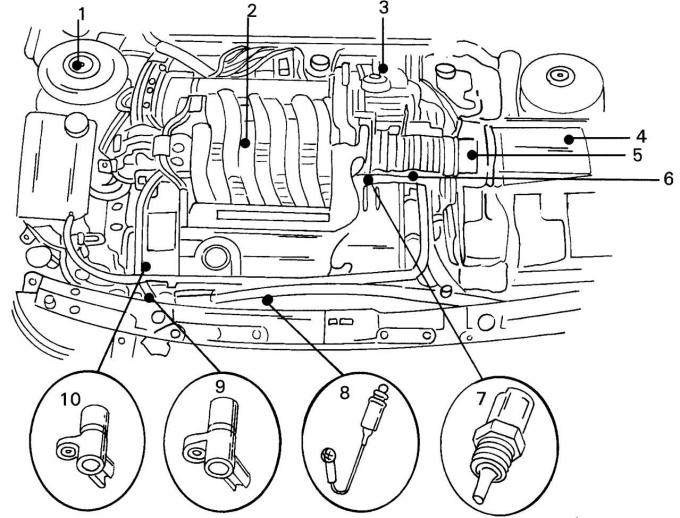
Pic. 142. Location in the engine compartment of some components of the 16-valve engine: 1 - EECV control unit; 2 - throttle position sensor; 3 — the air valve of adjustment of idling; 4 - camshaft position sensor; 5 - air meter; 6 - intake air temperature sensor; 7 - coolant temperature sensor; 8 - crankshaft position sensor; 9 - heated lambda probe
The fuel injection system of a 16-valve engine is shown in fig. 142.
coolant temperature sensor constantly informs the control unit of the current temperature of the coolant. It works on the principle of a temperature sensitive resistance switch.
Idle air control valve allows you to equalize small fluctuations in idling at the command of the control unit. Therefore, idling can be maintained under all load conditions.
Throttle position sensor informs the control unit about the current throttle position.
Lambda probe (oxygen sensor) measures the oxygen content in the exhaust gases, based on this information, the EEC V control unit «allows» operation of the catalytic converter. The sensor starts working only after the operating temperature has been reached. It is located in front of the converter in the exhaust gas stream. The sensor is equipped with a heater that starts working when the ignition is switched on and ensures that the converter starts up quickly in the mode with the best operating temperature of 300°C;
Temperature detection sensor incoming air (in the air intake hose).
Air mass meter (mass air flow sensor) works together with the so-called «hot wire», which, by changing the resistance, measures the mass of the passing intake air. The sensor is located in the air filter housing and can be recognized by the attached multi-pin plug. «hot wire» constantly has a temperature that is 200°C higher than the air temperature. By maintaining this difference in temperature, the air flow is adjusted accordingly.
Camshaft position sensor installed on the front side of the camshaft drive gear, gives the control unit information on the first cylinder, which allows fuel injection in the required sequence.
Position sensor (rotation angle) crankshaft, informs the control unit about the position of the crankshaft and controls the rotation of the flywheel. The flywheel has 36 landmarks. At position 90°before TDC, one of these reference points is missing, which serves as an indication to the control unit for the position of the crankshaft.
The engine control unit— EEC V.
nozzles are located immediately before the intake valves of the cylinders and are installed in the fuel distributor pipeline. In accordance with the exact calculation of the control unit, each cylinder receives the necessary portion of fuel for two piston strokes. After the first revolution of the crankshaft, the first half of the fuel portion is injected into the intake air. When the intake valve opens (on a four-cylinder engine always after two revolutions of the crankshaft), the combustible mixture rushes into the cylinder along with the second half of the portion, which is injected into the air stream.
Fuel pressure regulator. Located at the end of the fuel distributor pipeline. Operates mechanically with a spring-loaded diaphragm. It regulates the fuel pressure in the injectors. Excess fuel is directed through the return line back to the fuel tank.

Pic. 143. Location in the engine compartment of some components of the V6 engine: 1 - EECV control unit; 2 - heated lambda probe, rear; 3 — the air valve of adjustment of idling; 4 - intake air temperature sensor; 5 - air meter; 6 - throttle position sensor; 7 - coolant temperature sensor; 8 - heated lambda probe, in front; 9 - crankshaft position sensor; 10 - camshaft position sensor
The main difference between the injection system of the V6 engine (pic. 143) - the presence of two lambda probes (front and back) and six fuel injectors instead of four on the 16-valve engine.
Visitor comments